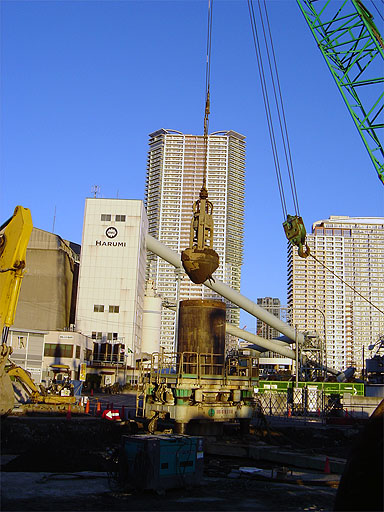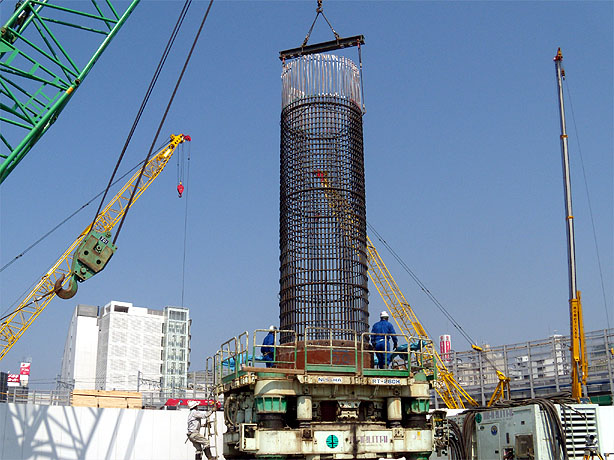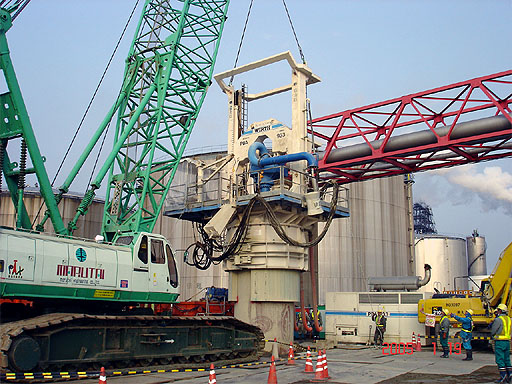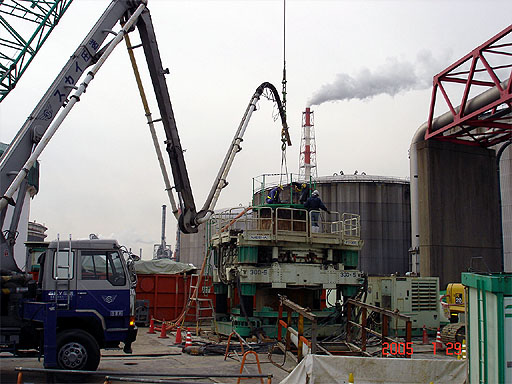-
- Service
- Actual Result
- Technical Guide 1
Steel Pile Driving (Straight/Battered Pile)
& Steel Pipe Sheet Pile Driving - Technical Guide 2
Cast in Place Pile - Technical Guide 3
Other Works
Construction Methods No. 2
Cast-In-Place Pile
(1) Perimeter rotating all-casing method
By installing a special blade on the tip of a casing, rotating the casing tube around the perimeter and then by indenting it, it is possible to drill through underground obstacles, boulders or even bedrocks. A hammer grab bucket is normally used for drilling inside the casing. A chisel, down-the-hole hammer, or rock auger may also be used in some cases. The characteristic is quite similar to all casing method; however, this method enabled extraction of underground obstacles, large diameter boulder or drilling of bedrock, whereas, it was not possible so with "injection" and "vibration" methods.
Characteristic
- By giving the strong rotation power, it is possible to drill the bedrocks and boulders, and cut steel reinforced concrete
- In drilling of boulders, a hammer-grab-bucket grabs and extracts them
- Because the casing tube rotates 360 degree, higher verticality is obtainable, being superior in friction cut compared to the conventional vibration method, and great deep drilling is possible
- By using the casing tube throughout the length of the borehole, pile shape is easier ensured to avoid porous wall collapse and damage to the neighboring structure
- Easier to evaluate the drilling ground

Drilling

Erection of steel reinforcement
(2) Reverse Method
In this method, weight is applied with a drill collar onto the wing bit or roller bit installed on the point of a drill pipe, and then a drill string is rotated with a rotary table or top drive (power swivel) to drill the bedrock. Debris is extracted continuously with a pump suction or an air-lifting method to the ground surface.
For protection of porous wall, s standpipe is placed on the wall surface. In the deep area below the standpipe, protection is kept by the water head difference between the level of mud-cake and residue water formed by buddy water in the porous wall and underground water.
Characteristic
- The drill diameter may be freely selected. It is possible for bedrock drilling with size between 0.8~3.0m
- Because of a use of water, it is a suitable method for works on water. With an air-lifting method, it is possible for great deep drilling of over 100m
- 19.6kPa of still water pressure is applied over the porous wall to stabilize it; no extensive casing is necessary
- A method with minimum noise and vibration

Drilling

Concrete Placement


